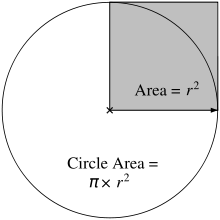I’m late for π day
Want to share your content on R-bloggers? click here if you have a blog, or here if you don't.
It is officially no longer pi day, but I didn’t see this Drew Conway post about estimating pi until just a few minutes ago. Because Google Reader doesn’t show github embeds, I also got to try it without seeing Drew’s solution. The estimation method relies on exploiting the area of a circle.

We can use R to generate random numbers for our and
coordinates and count up the number of
pairs inside the circle (or quarter of a circle, in our case). Because
is the area of our quarter circle, the ratio of the 4 times the number of random coordinates within the quarter circle to the total number of random coordinates should converge on
. This is a very simple Monte Carlo integration. So what do we get?
 |
| From pi day |
Gets pretty close! The final error was , not too shabby! I’m computing the running sample average, so it isn’t a true Monte Carlo, but it converges well enough. Code is below:
R-bloggers.com offers daily e-mail updates about R news and tutorials about learning R and many other topics. Click here if you're looking to post or find an R/data-science job.
Want to share your content on R-bloggers? click here if you have a blog, or here if you don't.
